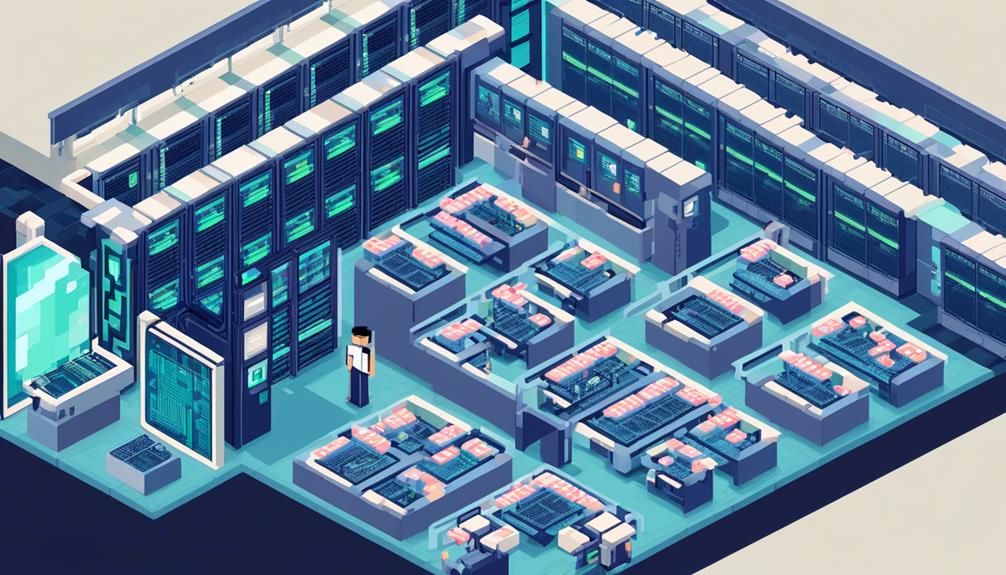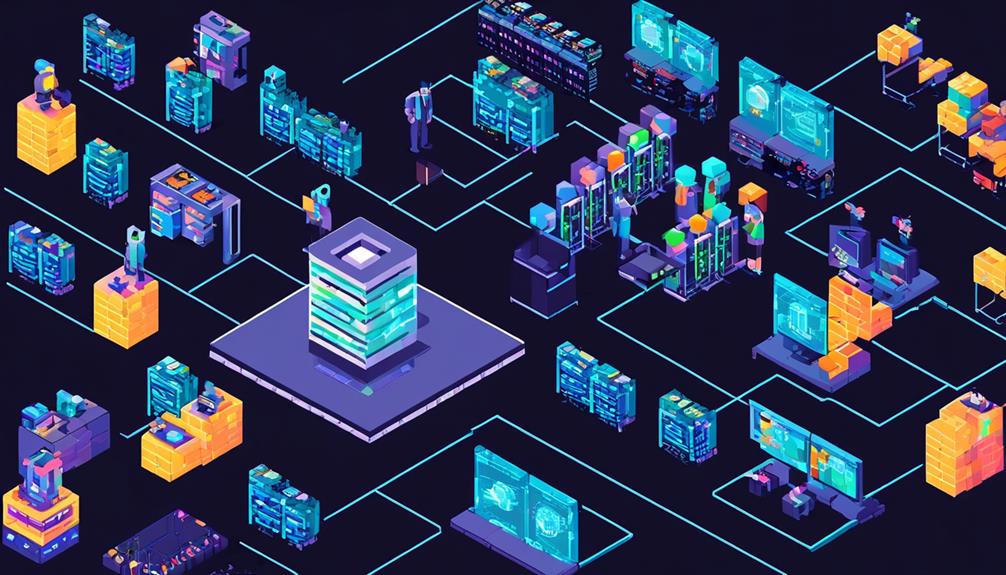In today's fast-paced digital landscape, data centers play a critical role in supporting the ever-increasing demand for storage, processing power, and connectivity. However, with the exponential growth of data and the complexity of managing these sprawling infrastructures, organizations are constantly seeking ways to optimize their data center operations.
This is where Artificial Intelligence (AI) steps in, offering a transformative solution that can revolutionize the way data centers are managed. By leveraging AI-driven infrastructure monitoring, predictive maintenance, automated resource allocation, enhanced energy efficiency, streamlined security, intelligent capacity planning, real-time performance monitoring, and autonomous operations, organizations can unlock unparalleled efficiency, cost savings, and scalability.
But how exactly does AI enable such optimizations, and what are the benefits it brings to the table? Let's explore further.
Key Takeaways
- AI-driven infrastructure optimization uses advanced algorithms and predictive analytics to optimize data center operations, improving performance and reducing energy consumption.
- Predictive maintenance and security enable proactive maintenance actions and identify potential equipment failures and security threats in real-time, enhancing data center security and reducing the risk of data breaches.
- Proactive equipment maintenance utilizes AI and machine learning algorithms to identify patterns and anomalies in data, reducing the risk of costly equipment failures and unplanned downtime.
- Automated resource allocation and optimization driven by AI and machine learning optimize the allocation of resources and prevent data and power outages by monitoring and analyzing data center operations.
AI-driven Infrastructure Monitoring

AI-driven Infrastructure Monitoring is a powerful and efficient approach that leverages artificial intelligence and machine learning techniques to optimize data center operations and ensure seamless performance. With the increasing demand for data centers, it is crucial to find innovative solutions that can keep up with this demand while maximizing efficiency and minimizing downtime. AI-driven infrastructure monitoring provides a solution to this challenge by utilizing advanced algorithms and predictive analytics.
One key aspect of AI-driven infrastructure monitoring is the use of machine learning algorithms to optimize resource utilization. By analyzing historical data and real-time performance metrics, AI systems can dynamically allocate resources such as CPU, memory, and storage, ensuring that they are efficiently utilized. This not only improves the overall performance of the data center but also helps to reduce energy consumption.
Energy consumption is a significant concern for data centers, and AI-driven infrastructure monitoring can play a crucial role in optimizing energy usage. By analyzing data center cooling systems and power distribution, AI systems can identify areas of inefficiency and recommend adjustments to improve energy efficiency. This can result in significant cost savings and a reduced environmental footprint.
Another important metric in data center operations is Power Usage Effectiveness (PUE), which measures the energy efficiency of a facility. AI-driven infrastructure monitoring can help optimize PUE by identifying opportunities to reduce energy waste and improve overall efficiency. By continuously monitoring and analyzing data, AI systems can provide real-time insights and recommendations to data center operators.
Predictive Maintenance and Fault Detection
Predictive maintenance and fault detection are crucial aspects of optimizing data center operations with AI. Real-time anomaly detection allows for the identification of potential equipment failures before they occur, enabling proactive maintenance actions to be taken.
Real-Time Anomaly Detection
Real-Time Anomaly Detection, a groundbreaking application of AI technology, revolutionizes data center operations by proactively identifying and addressing potential equipment failures and security threats. Leveraging machine learning algorithms, this powerful tool constantly monitors real-time data from compute resources, network traffic, and storage systems, allowing data center operators to optimize their operations.
Here's how Real-Time Anomaly Detection enhances data center performance:
- Predictive Maintenance: By learning normal network behaviors, AI software can detect anomalies and deviations, enabling proactive response to potential threats. It anticipates and prevents equipment failures, preventing data and power outages and potentially saving significant revenue.
- Enhanced Security: Real-Time Anomaly Detection contributes to data center security by identifying and addressing security loopholes, malware, and potential cyber threats. It helps data centers stay one step ahead of attackers, minimizing the risk of data breaches and ensuring the protection of critical assets.
- Efficient Resource Allocation: By analyzing server performance, network congestion, and disk utilization, AI algorithms optimize resource allocation, ensuring efficient utilization of compute resources. This leads to improved operational efficiency and cost savings for data center operators.
Proactive Equipment Maintenance
Building on the foundation of real-time anomaly detection, the next critical aspect to optimize data center operations is proactive equipment maintenance. This proactive strategy encompasses both predictive maintenance and fault detection.
AI and machine learning (ML) algorithms can play a crucial role in implementing these proactive strategies. Predictive maintenance utilizes ML algorithms to analyze data and predict potential equipment failures before they occur. By identifying patterns and anomalies in the data, predictive maintenance enables proactive interventions, reducing the risk of costly equipment failures and unplanned downtime.
Additionally, fault detection with AI continuously monitors equipment performance and detects anomalies, allowing for early intervention to prevent failures.
Implementing proactive equipment maintenance strategies can lead to significant cost savings by avoiding unplanned downtime and reducing the need for reactive maintenance. Furthermore, it optimizes data center operations, improves equipment lifespan, and enhances overall operational efficiency, while also reducing energy consumption in data center cooling.
Automated Resource Allocation and Optimization

Automated resource allocation and optimization in data centers is a crucial process driven by AI and machine learning to meet the increasing demand for efficient operations. Data center operators rely on AI systems to optimize the allocation of resources such as servers, storage, and network bandwidth. By leveraging AI algorithms, data centers can achieve higher levels of efficiency and productivity.
Here are three key ways in which automated resource allocation and optimization with AI are transforming data center operations:
- Improved task allocation: AI systems utilize cluster scheduling algorithms to allocate tasks across all servers in real-time. This dynamic allocation ensures that resources are utilized optimally, leading to improved efficiency and reduced latency. Studies have shown that AI-driven resource allocation can increase efficiency by 20-30%, enabling data centers to handle higher workloads without compromising performance.
- Specialized AI chips: To enhance the incorporation of AI tools and techniques in data center resource allocation, specialized AI chips are emerging. These chips are designed to accelerate AI computations and improve the efficiency of resource allocation algorithms. By leveraging these specialized chips, data centers can further enhance their optimization capabilities and deliver faster and more accurate resource allocation decisions.
- Proactive outage prevention: Automated resource allocation and optimization with AI can anticipate and prevent data and power outages. By continuously monitoring data center operations and analyzing historical data, AI systems can identify potential bottlenecks or failures. This proactive approach allows data center operators to take preemptive actions, avoiding costly downtime and potential revenue loss.
Enhanced Energy Efficiency and Sustainability
Enhanced energy efficiency and sustainability are critical goals for data centers, considering their significant environmental impact and operational costs.
By implementing energy reduction strategies and sustainable infrastructure advancements, data centers can minimize their carbon footprint and contribute to a greener future.
AI-driven optimization techniques, such as machine learning algorithms and intelligent resource allocation, can play a pivotal role in achieving these goals by predicting and preventing energy wastage, optimizing cooling systems, and reducing overall energy consumption.
Energy Reduction Strategies
Implementing AI-driven strategies can significantly enhance energy efficiency and sustainability in data centers. By leveraging AI and machine learning, data centers can optimize their operations to reduce energy consumption and minimize their carbon footprint. Here are three energy reduction strategies that AI can facilitate:
- Optimizing cooling systems: AI algorithms can analyze real-time data on temperature, humidity, and airflow to dynamically adjust cooling systems. This ensures that cooling resources are efficiently allocated, reducing energy waste.
- Managing server workloads: AI can analyze historical data and predict future workload demands. By dynamically allocating computing resources based on these predictions, AI optimizes server utilization and reduces energy consumption.
- Preventing power outages: AI algorithms can analyze power usage patterns and detect anomalies that may lead to outages. By proactively identifying potential issues, data centers can take preventive measures, ensuring uninterrupted operations and avoiding revenue loss.
Sustainable Infrastructure Advancements
Sustainable infrastructure advancements in data centers focus on achieving enhanced energy efficiency and sustainability through the utilization of AI-driven strategies.
Enhanced energy efficiency in data centers is realized through various AI-optimized approaches. For instance, AI is employed to optimize cooling systems, ensuring that they operate at the most energy-efficient levels.
Additionally, AI-driven algorithms enable power usage based on demand, further reducing energy wastage.
Sustainable infrastructure advancements also leverage AI for predictive maintenance, which helps identify potential issues before they escalate, reducing energy consumption and improving overall efficiency.
AI-driven resource allocation optimizes energy usage by dynamically allocating resources based on demand, contributing to sustainable infrastructure advancements in data centers.
Streamlined Data Center Security

Utilizing artificial intelligence (AI) in data center operations can significantly bolster the efficiency and effectiveness of security measures. With the increasing complexity and sophistication of cyber threats, data centers need advanced solutions to protect their valuable assets. AI-powered security systems offer a proactive approach to safeguarding data centers from potential breaches and vulnerabilities.
Here are three ways AI streamlines data center security:
- Threat detection and prevention: AI can detect and report deviations from normal behaviors, allowing data center operators to quickly identify and respond to potential cyber threats. By analyzing incoming and outgoing data, AI can detect security loopholes, malware, and suspicious activities, ensuring a robust defense against unauthorized access.
- Predictive analytics: AI's machine learning capabilities enable it to predict and prevent data breaches before they occur. By analyzing historical data and patterns, AI algorithms can identify potential vulnerabilities and take proactive measures to mitigate risks. This helps data centers stay one step ahead of attackers and reduce the risk of security threats.
- Resource optimization: AI can optimize resource allocation in data centers, leading to improved security and operational efficiency. By analyzing server performance and power consumption patterns, AI can identify anomalies and optimize resource allocation to prevent data and power outages. This not only saves centers from potential revenue loss but also enhances the overall reliability of the data center infrastructure.
With AI-powered security systems, data centers can enhance their security posture and protect their critical assets from evolving cyber threats. By leveraging AI's capabilities in threat detection, predictive analytics, and resource optimization, data centers can ensure a streamlined and robust security framework that keeps pace with the ever-changing threat landscape.
Intelligent Capacity Planning and Scaling
Intelligent capacity planning and scaling in data centers can be optimized through the implementation of AI and machine learning techniques. By leveraging these technologies, data centers can effectively meet the increasing demand for computational resources while improving overall efficiency and performance.
One significant impact of AI in capacity planning is its ability to optimize resource allocation and scheduling. AI systems use cluster scheduling algorithms to allocate tasks across servers in real-time, enhancing efficiency by 20-30%. This ensures that computational resources are utilized optimally, minimizing wastage and maximizing throughput.
Furthermore, AI can help prevent data and power outages through predictive learning. By analyzing historical data and patterns, AI systems can anticipate potential issues and take proactive measures to prevent disruptions. This not only saves revenue but also ensures uninterrupted operations, which is crucial for businesses relying on data centers for their critical operations.
AI's predictive capabilities also enable data centers to anticipate demands and optimize scaling before receiving requests. By analyzing historical data and trends, AI can accurately predict when additional resources will be needed and scale up the capacity accordingly. This improves data center performance and responsiveness, ensuring that users experience minimal delays or downtime.
The impact of AI in capacity planning and scaling is evident in its ability to lower costs and improve efficiencies. By accurately predicting demand and optimizing resource allocation, data centers can avoid overprovisioning and reduce unnecessary expenses. Additionally, the automation and intelligence provided by AI reduce the need for manual intervention, further streamlining operations and improving overall efficiency.
Real-time Performance Monitoring and Analytics

To continue enhancing the optimization of data center operations, a crucial aspect to consider is real-time performance monitoring and analytics. This capability enables immediate visibility into the performance of various components within the data center, providing valuable insights for efficient management and resource allocation.
Here are three key benefits of real-time performance monitoring and analytics in optimizing data center operations:
- Proactive Issue Identification and Resolution: Real-time performance monitoring allows for the proactive identification of issues such as server performance degradation, network congestion, and resource bottlenecks. By continuously monitoring these metrics, data center management can quickly detect and address potential problems before they escalate, minimizing downtime and optimizing overall performance.
- Predictive Analytics for Preventive Maintenance: AI-driven analytics can analyze historical data to identify patterns and trends in resource consumption and performance. By leveraging machine learning algorithms, data center operators can predict and prevent potential outages and failures before they occur. This proactive approach to maintenance helps to ensure uninterrupted operations and improve the reliability of the data center infrastructure.
- Resource Optimization and Efficiency: Real-time performance monitoring and analytics provide valuable insights into resource utilization, allowing data center operators to optimize resource allocation and scheduling. By understanding the demands on servers, storage, and network infrastructure, operators can make informed decisions to maximize efficiency and minimize wastage. This optimization of resources not only improves performance but also helps to reduce operational costs.
Autonomous Data Center Operations
With the increasing demand for optimized data centers, autonomous operations powered by AI and machine learning have emerged as a crucial solution. AI and machine learning technologies enable data centers to optimize their operations, improve efficiency, and enhance security. These advanced technologies can predict and prevent data and power outages, saving data centers from potential revenue loss.
One of the key benefits of autonomous data center operations is their ability to optimize resource allocation. AI systems utilize cluster scheduling algorithms to allocate tasks across servers in real-time, increasing efficiency by 20-30%. This ensures that computing resources are utilized effectively, minimizing wastage and maximizing performance.
Furthermore, AI and machine learning play a vital role in enhancing data center security. These technologies can detect and report deviations from normal behaviors, enabling early detection and prevention of potential data breaches. By constantly monitoring and analyzing network traffic and user behavior patterns, AI-powered systems can identify suspicious activities and take immediate action.
To facilitate the seamless incorporation of AI tools and techniques, specialized AI chips are emerging in the market. These chips are designed to handle the complex computations required for AI and ML applications, enabling faster and more efficient processing.
Frequently Asked Questions
How Is AI Used in Data Centers?
AI is used in data centers for various purposes such as predictive maintenance, energy efficiency, fault detection, resource allocation, capacity planning, security monitoring, and performance optimization.
By leveraging machine learning algorithms, AI can predict equipment failures and schedule maintenance proactively, ensuring uninterrupted operations.
It can also optimize energy consumption by dynamically adjusting resource allocation based on workload demands.
Furthermore, AI enables real-time monitoring of network traffic and detects any abnormal activities, enhancing security measures.
Ultimately, AI plays a critical role in optimizing data center operations and improving overall efficiency.
How to AI Can Be Used for Data Management?
AI can be used for data management through various techniques. These include AI-driven data analysis, machine learning for data management, automation in data center operations, predictive analytics for data optimization, AI-assisted data storage and retrieval, cognitive computing for data management, and AI-enabled data governance.
These technologies enable organizations to efficiently process and analyze large volumes of data. They also automate repetitive tasks, optimize resource allocation, and ensure data security and governance.
How Can AI Be Used in Operations?
AI can be used in operations to optimize data center performance and efficiency.
AI powered predictive maintenance ensures timely maintenance of equipment, reducing downtime.
AI driven capacity planning helps in resource allocation and scaling as per demand.
AI based anomaly detection identifies and resolves abnormal behavior, enhancing security.
AI enabled energy optimization minimizes power consumption.
AI driven automation streamlines operations, improving productivity.
AI powered performance monitoring tracks system performance in real-time.
AI based fault prediction and prevention minimizes system failures, enhancing reliability.
What Is Process Optimization Using Artificial Intelligence?
Process optimization using artificial intelligence (AI) refers to the application of AI algorithms and machine learning techniques to improve the efficiency and effectiveness of various operational processes across industries.
It involves leveraging AI-driven tools and platforms to analyze large volumes of data, identify patterns, and make data-driven decisions to optimize workflows.
Successful examples of process optimization using AI include enhancing supply chain management, streamlining manufacturing processes, and improving customer service.
However, implementing AI-based process optimization also comes with challenges such as data quality, algorithm bias, and ethical considerations.
When choosing an AI solution for process optimization, key factors to consider include the scalability, interpretability, and transparency of the AI model.
The use of AI for process optimization raises ethical implications in terms of privacy, security, and job displacement.
Currently, there are various AI-powered process optimization tools and platforms available in the market, such as predictive analytics software, robotic process automation, and intelligent process automation.
Future trends and advancements in AI-driven process optimization techniques include the integration of AI with the Internet of Things (IoT), edge computing, and the development of explainable AI models.

